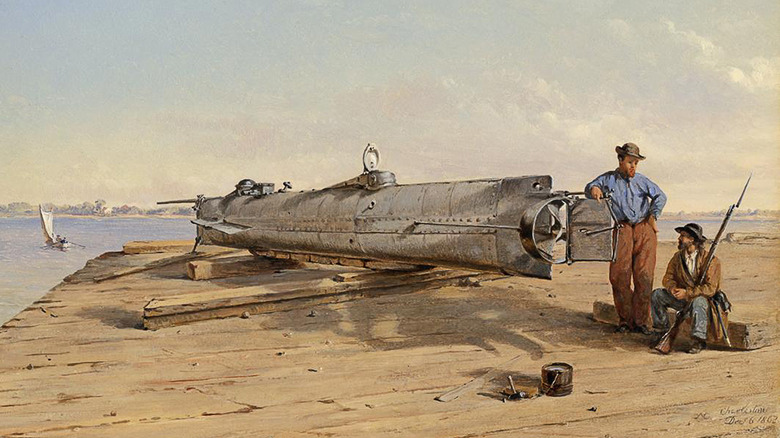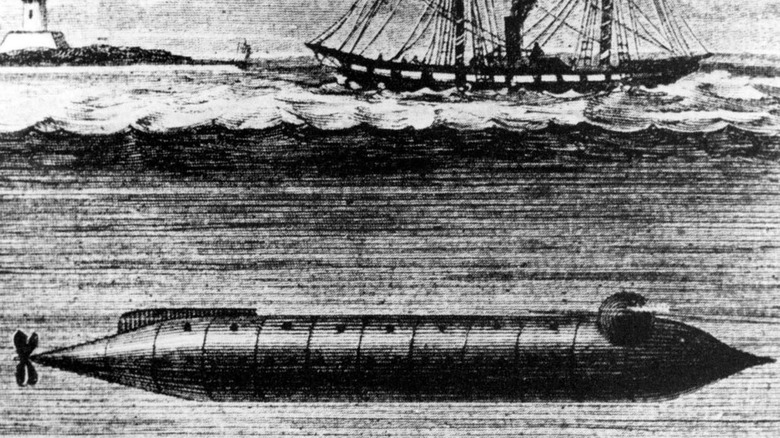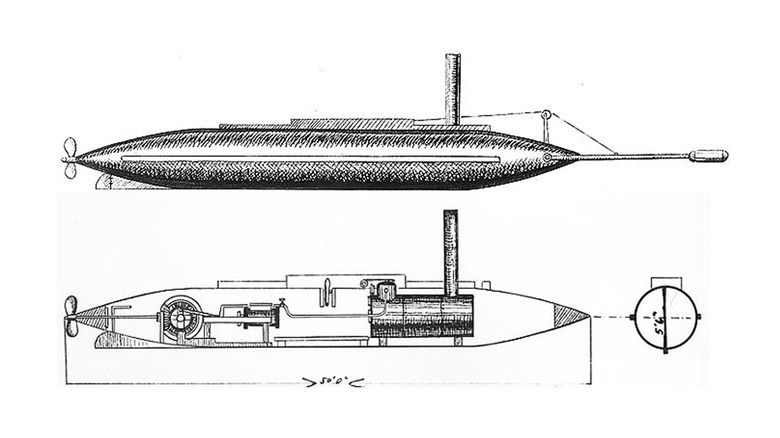How The Submarines Of The Civil War Were Made
Whether it's because of the famous German U-boats of World War II or the movie "The Hunt for Red October," we're all familiar with submarines. Long, sinister-looking vessels that sneak around underwater, packed with lethal missiles and torpedoes and crewed by brave young sailors who don't mind confined spaces. But what many people don't realize is that modern submarines have their origins in designs dating from the earliest years of the American Civil War.
The world's first successful submarine attack occurred more than 150 years ago, in 1864. Unbeknown to the crew, it was a suicide mission. On February 17 of that year, the 40-foot-long Confederate vessel H.L. Hunley rammed a contact mine into the USS Housatonic, laying at anchor near Charleston Harbor. The resulting explosion ripped a hole in the side of the Union warship but is also believed to have fatally damaged the Hunley, which sank with all hands. The unlucky vessel had actually sunk twice before, killing two crews and its inventor, Horace Hunley himself, but this time it didn't come back up — at least not until the year 2000 when it was recovered intact by conservationists.
The Hunley might have been the most famous Civil War submarine, but it was only one of several submersible and semi-submersible vessels to see service in America's defining conflict.
Development and weaponry
While both sides were working on the development of submersibles, it was the Confederacy that turned them into practical weapons of war in an effort to combat the Union blockade of Confederate ports. Before inventor Horace Lawson Hunley designed the vessel that bore his name, he a demonstrator dubbed The Pioneer, in 1861. That same year, the U.S. Navy commissioned its first submarine, a 275-ton green-painted beast that became known as the Alligator.
The H.L. Hunley and the Alligator were constructed from iron and wood, and both were human powered. Of the Hunley's eight-man crew, seven powered its single propeller by hand, while the Alligator was originally powered by 16 hand-rowed oars before getting upgraded to a hand-cranked propeller. Both submarines could manage a speed of only around four knots (about 4.5 mph). Still, by the standards of the time, they were highly advanced vessels that introduced many features that modern-day submariners would recognize, including ballast tanks and movable "hydroplanes" for directional control.
The weapons that they carried, however, were very different. The "spar torpedoes" Confederate submersibles used had little in common with the torpedoes we know today. Technically, they were contact mines with barbed points attached to a long boom extending from the front of the vessels. The submarine attacked by ramming its target, hopefully embedding the barbed mine in its hull. The attacker would then hopefully back away, detaching the mine and unspooling a trigger cable that detonated the device automatically from a safe distance.
Other Civil War Submersibles
While the Hunley and the Alligator are the best known of the Civil War submarines, the most numerous were technically semi-submersibles. It was a Charleston physician, St. Julien Ravenel, who came up with the first successful design, the CSS David.
The steam-powered David wasn't a submarine in the truest sense. The body of the 50-foot-long vessel lay beneath the waterline, its smokestack extended several feet above the waves. At night or in low-visibility conditions, it was hard to spot, but not impossible. In fact, during the David's first deployment in October 1863, a lookout on its target, the USS New Ironsides, spotted it just as it was about to attack.
The David successfully rammed its spar torpedo into the New Ironsides but soon afterward was swamped by the massive plume of water generated by the explosion. The water entered the David's smokestack and put out its boiler fire, rendering the vessel dead in the water. The metal-hulled USS New Ironsides, meanwhile, was unharmed. The David eventually got back underway and made further (unsuccessful) attacks on Union ships. It is believed that up to 20 copies of the David may have been produced by Confederate shipyards before the end of the conflict, but all were likely captured or lost by the time the war's end in 1865.
As for the Union's only Civil War submarine, the Alligator sank in heavy seas on April 2, 1863, before it could be used in combat. It has never been recovered.


